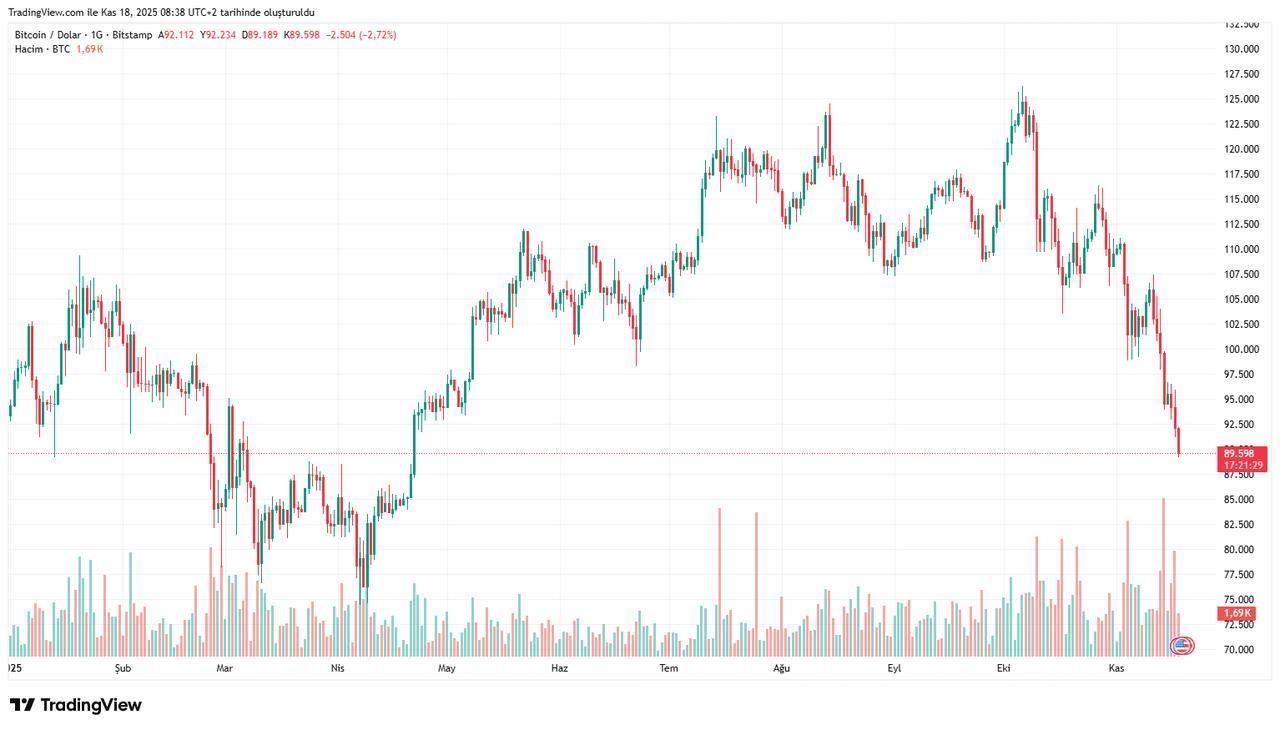
Asian stocks fell sharply on Tuesday as investor caution intensified ahead of key earnings from U.S. chipmaker Nvidia—seen as pivotal amid growing fears of a potential blow to the AI bubble—and amid uncertainty surrounding the Federal Reserve’s next policy move, as well as escalating tensions between China and Japan over Taiwan.
The risk-off sentiment extended to digital assets, with Bitcoin falling below $90,000 and major cryptocurrencies retreating sharply, as fading hopes of a near-term Fed rate cut triggered a broad pullback in speculative assets.
Tokyo’s Nikkei 225 dropped more than 3%, hitting an intraday low of 48,656 points, while Shanghai’s Composite Index slipped 0.8% to 3,936.73, following a statement from the Japanese embassy in China advising its nationals to remain vigilant and avoid crowded areas.
Elsewhere in the region, Seoul’s KOSPI retreated over 3% to 3,965.90, Hong Kong’s Hang Seng Index shed nearly 2% to 25,868.97, the Sydney S&P/ASX 200 fell nearly 2% to 8,469.10, and Taipei’s TPEX lost more than 2.3% to 250.06.
Last week, Japanese Prime Minister Sanae Takaichi sparked backlash in Beijing after suggesting Tokyo could intervene militarily in the event of a Chinese assault on Taiwan.
China, which views Taiwan as part of its territory and has not ruled out forceful reunification, summoned the Japanese ambassador and urged the Prime Minister to retract her remarks.
In a reciprocal move, Tokyo summoned China’s ambassador over what it described as an "inappropriate" and subsequently removed online post.
In response, China on Monday advised its citizens to avoid travel to Japan, weighing on Japanese tourism and retail stocks, as the country had drawn nearly 7.5 million Chinese visitors in the first nine months of 2025.
Adding to the growing tensions, the Japanese embassy in China issued a statement on Tuesday urging its nationals to stay vigilant and avoid crowded locations. As the diplomatic row escalated, state media reported that the screenings of at least two Japanese films in China would be postponed.

Compounding market anxiety in Japan was a fresh economic contraction. Gross domestic product shrank 1.8% year-on-year in the third quarter, marking the first annual decline since the first quarter of 2024. The downturn was attributed to falling exports amid rising U.S. trade tariffs.
Investors also reacted to bond market developments, with Japan’s 10-year government bond yield rising to 1.73%, the highest level since June 2008, while 40-year bond yields reached a record 3.680%.
Prime Minister Takaichi has instructed her cabinet to draw up a new fiscal stimulus package exceeding 17 trillion yen, or approximately $110 billion, which Finance Minister Satsuki Katayama said would aim to support domestic demand and economic activity. Cabinet approval is expected by Friday.
On the currency front, Katayama also voiced concern on Tuesday over recent foreign exchange fluctuations, as the yen fell to its lowest level against the U.S. dollar in nine months, with the USD/JPY rate reaching 155.12.
She described the movements as "one-sided and rapid," adding that the government was closely monitoring the market for excessive volatility.
Focus in the region also turned to Japan’s new Prime Minister Sanae Takaichi’s meeting with Bank of Japan (BOJ) Governor Kazuo Ueda on Tuesday—the first official discussions between the two since she took office last month.
The BOJ had previously kept its benchmark interest rate steady at 0.5% during its October policy meeting, held shortly after Takaichi’s inauguration.
These losses followed the Dow Jones Industrial Average’s 1.18% decline on Monday, signaling a wider shift in investor appetite away from risk assets.
The pullback came as traders reassessed the sustainability of this year’s powerful rally in technology stocks, particularly those linked to artificial intelligence (AI). Nvidia, seen as a cornerstone of the AI investment theme, is set to report earnings on Wednesday.
Market watchers are expected to closely scrutinize the figures to gauge whether the heavy investments in AI infrastructure are beginning to yield returns.
The broader mood was also weighed down by expectations for the upcoming release of the delayed U.S. September jobs report on Thursday, which could shape the Federal Reserve’s stance on interest rates.
While hopes for a December rate cut had buoyed markets earlier this year, Federal Reserve Chair Jerome Powell recently noted that such a move is not a "foregone conclusion," citing ongoing inflationary pressures.

Cryptocurrency markets mirrored the broader risk-off tone, with major digital assets retreating. Bitcoin fell 5.5% to $89,598, erasing all its year-to-date gains after having risen as much as 35% earlier in 2025.
The token has declined more than 25% since peaking at a record $126,251 last month. Ethereum dropped 5.5% to $3,004.28, while XRP fell 4.1% to $2.15. The total market capitalization of cryptocurrencies contracted 4.3% to $3.1 trillion, down from the all-time high of $4.2 trillion recorded in early October.
In precious metals, gold continued its downward trend—following a brief bounce after the end of the U.S. government shutdown above $4,200 — falling 0.6% to $4,022.04 per ounce. Silver dropped 0.8% to $49.80, palladium declined 1% to $1,388.69, and platinum also fell 1% to $1,517.24.
Oil prices were also under pressure, as loadings resumed at Russia’s key Black Sea export hub of Novorossiysk following a two-day suspension, bringing prices lower.
West Texas Intermediate crude dropped nearly 1% to $59.51 per barrel, while Brent crude slipped to $63.79.